Scientific Name
Pandanus amaryllifolius Roxb.
Synonyms
Pandanus hasskarlii Merr., Pandanus latifolius Hassk. [Illegitimate], Pandanus latifolius var. minor Hassk., Pandanus odorus Ridl. [1]
Vernacular Name
| Malaysia | Pandan wangi [2] |
| English | Fragrant pandan, fragrant screwpine [2] |
| China | Xiang lu dou [2] |
| India | Ambemohor-pat, ambemohor patta [2] |
| Indonesia | Daun pandan, pandan rampe, pandan rampeh, pandan wangi, pondak [2] |
| Thailand | Bai toey, panae-wo-nging, toei-hom [2] |
| Laos | Të:y ho:m, të:y ba:nz [2] |
| Philippines | Pandan, pandan mabango [2] |
| Cambodia | Taëy [2] |
| Vietnam | D[uws]a th[ow]m [2] |
| Papua New Guinea | Karuka [2] |
Geographical Distributions
Pandanus amaryllifolius has been originated from Bangka, Indonesia, but is widely distributed in the tropical areas of Southeast Asia. Although this plant has existed for centuries in Malaysia, it is now mainly grown in the kitchen garden. [3]
Botanical Description
P. amaryllifoliusis a member of the Pandanaceae family [1]. P. amaryllifoliusis a shrub that grows in clumps in two forms: up to height of 1.6 m as small form and up to 4.5 m as large form [3][4][5].
Stem is slender, about 2–5 cm thick. [4][5]
Leaves green to pale green, broad, linear, prominent twin lateral pleats above, the margins entire except at leaf apex with presence of few prickles with 1 mm long; adult leaves are about 80–110 cm long and 6–8 cm wide with rather abruptly rounded or acute tip. [4][5]
Male flowers are extremely rare, and there is no scientific description of a female flower for this species. [4][5]
Fruits also never been reported. [4][5]
Cultivation
Soil Suitability and Climate Requirement
P. amaryllifolius can be planted in various soil types. This includes problem soils like peat and sandy bris soil. It is suitable for soil with high moisture content. However, it can withstand long droughts up to 1-2 months. Total annual rainfall of 200–300 cm and tropical conditions with temperature range of 18–28ºC is ideal for its growth. [6]
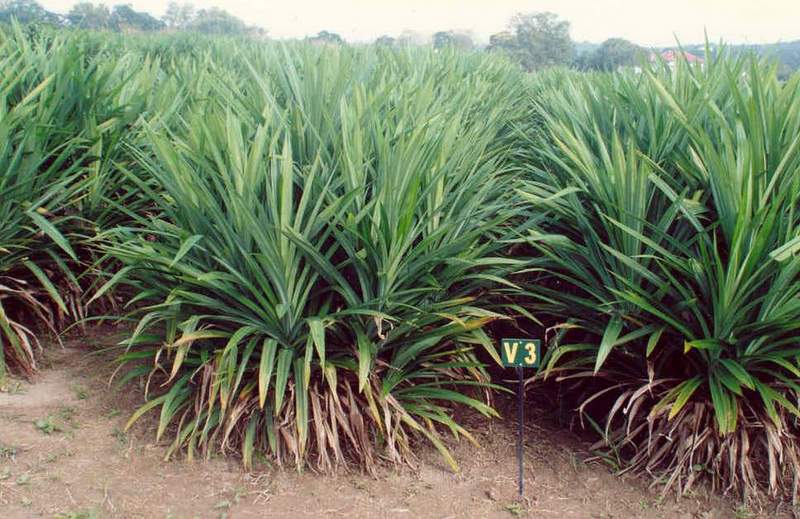
Field Preparation
Land Preparation
For planting on virgin land, the land should be thoroughly cleared before a suitable drainage system is constructed. Ploughing is done to loosen the soil and control weed. Spraying with a systemic weedicide like glyphosate two weeks later will reduce weed competition at the early stage of growth. For soils with low pH (pH 4-5), liming with Ground Magnesium Limestone (GML) by broadcasting at the rate of 5 t/ha before ploughing is recommended. [6]
Production of Planting Materials
Suckers measuring 15-20 cm are used as planting material. Each sucker should have roots at least 1-2 cm long, or with some tissue from the main plant at the base of the sucker. To obtain many suckers at one time, the main plant is pruned to a height of 20-30 cm and left to grow again for two months. A few leaves at the base of the suckers are removed for easy planting. Approximately 25% of the leaves are pruned from the tip to reduce moisture loss through transpiration. It is recommended that the suckers are first planted in polybags before field planting. This process will encourage root growth. [6]
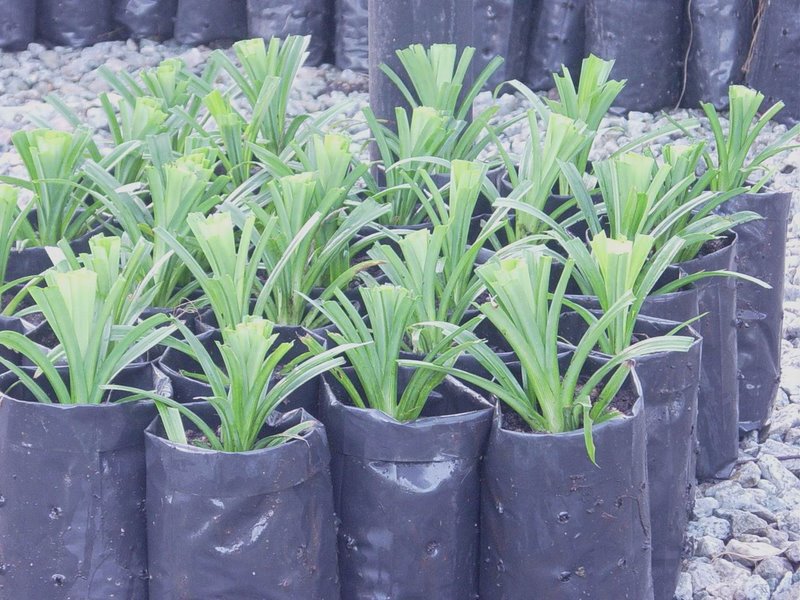
Field Planting
The planting distance recommended is 1.0 m between rows and 1.5 m within a row, for six rows of planting. This planting distance is followed by a 3.0 m space for field transportation of inputs and harvests. This will result in a planting density of 5,000 plants/ha. The planting hole is about 25 cm x 25 cm x 25 cm. Planting is done at the beginning of rainy season since the early stage of growth in the field needs sufficient water supply. [6]
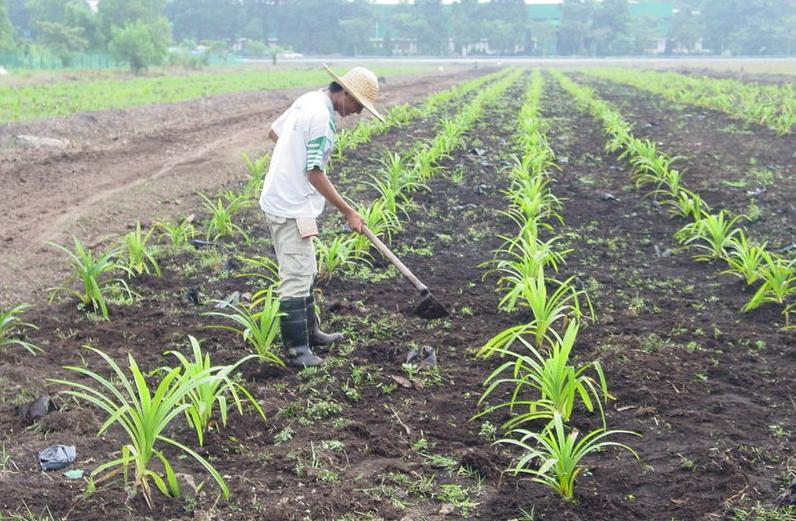
Field maintenance
Fertilisation
Super phosphate fertiliser or Christmas Island Rock Phosphate (CIRP) at the rate of 0.5 t/ha (100 g/hole) is used as the basal dressing. Compound fertiliser NPK (15:15:15) at the rate of 0.5 t/ha is applied as the side dressing at every harvest. Before the main harvest, fertiliser at the rate of 0.1 kg per plant is applied four times that is in the 2nd, 5th, 8th and 11th month after planting. On the other hand, for the ratoon crop, fertiliser application is split into three and applied in the 1st, 4th and 7th month after the last harvest. Liming is done at the rate of 5.0 t/ha twice after each harvest. The lime is broadcasted in between rows in the 4th and 10th month for the main harvest. For the ratoon crop, liming is done in the 3rd and 6th month after the last harvest. The above fertiliser recommendations are based on the crop production on peat soil. [6]
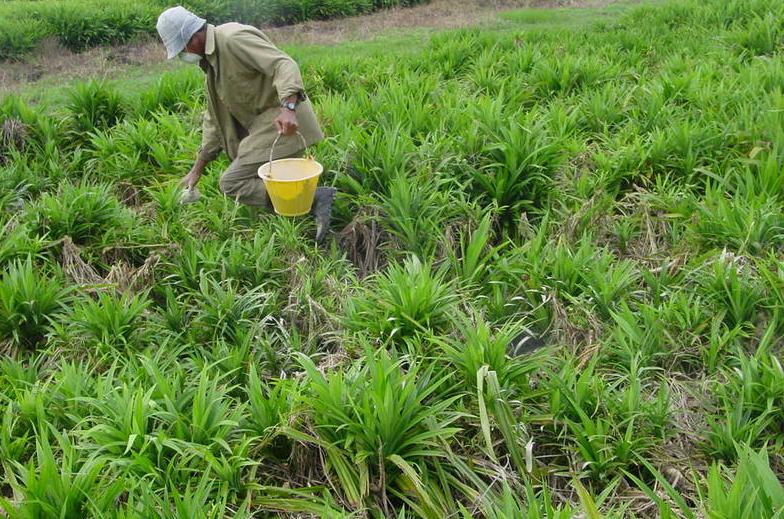
Weed Control
Ploughing and spraying of weedicide during field preparation help to reduce weed population at the early stage of plant growth. Weed control in the first 6 months after planting is done manually using a hoe. If necessary, it is done once every 2 months. After that, weeds are controlled by spraying systemic weedicide such as glyphosate, alternating with contact weedicide such as paraquat. Spraying is done every 2-3 months depending on weed population. The weed problem will be reduced when the plants start to get bushy and suckers start to develop and grow. [6]
Water management
The plant is more suitable for wet areas. For areas with high annual rainfall throughout the year, additional irrigation system is not needed. For crops in areas with prolonged drought, a sprinkler system is used to ensure optimum plant growth during the dry season. [6]
Pest and Disease Control
P. amaryllifolius does not have severe disease or pest problems. Because of that, scheduled spraying of the crop is not necessary. Application of chemical pesticides and fungicides is not recommended to maintain product quality. [6]
Harvesting
The main crop is harvested about 12 months after field planting. Harvesting can then be done at 8 month intervals after the first harvest. The harvesting time is indicated by the presence of a few leaves that begin to turn yellow and dry at the base of the plant. The plant is harvested by cutting the stem approximately 20-30 cm from the ground. The potential fresh weight yield for P. amaryllifolius grown on peat soil for the main, 1st, 2nd and 3rd ratoon harvests are 24.5, 43.0, 34.5 and 27.5 t/ha respectively. [6]
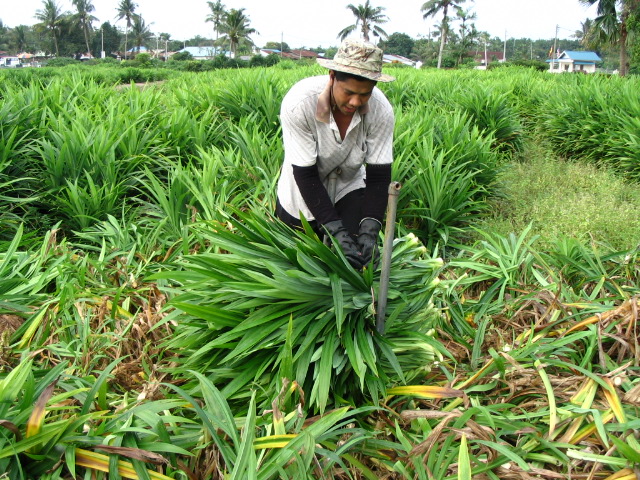
Postharvest handling
The yellow and dried leaves at the base of the plant are removed by cutting the base of the stem before packing for market. [6]
Estimated cost of production
Based on a three-year operation with 4 harvests, the total production cost per hectare for peat soil are approximately RM20,800, RM7,200, RM6,700 and RM6,300 for the main, 1st ratoon, 2nd ratoon and 3rd ratoon harvests. The average production cost per year is RM13, 660. The nett production cost of P. amaryllifolius is RM0.40/kg. The production cost was estimated based on the cost of current inputs during writing of this article. [6]
Chemical Constituent
Ethanol extract of P. amaryllifoliusleaves was found to contain gallic acid [7], epicatechin, naringin, catechin, kaempferol, gallic acid, cinnamic acid, ferrulic acid [8], and alkaloid (e.g. pandamarilactonines-A and-B) [9].
Ethanol (70%) extract of freeze-dried leaves of P. amaryllifolius was found to contain free amino acids (e.g. aspartic acid, glutamic acid, valine, threonine). [10]
Chloroform extract of fresh leaves of P. amaryllifolius was found to contain alkaloids (e.g. pandamarilactone-1, pandamarilactone-32 and pandamarilactone-31). [11]
Plant Part Used
Roots and leaves. [12][13]
Traditional Use
Traditionally, the fresh leaves of P. amaryllifoliusare applied to hair and as a lotion to treat measles and anaemia. It is used as in a drought to treat gonorrhoea, syphilis and sapraemia and also used for bathing after childbirth [14]. After soaking of the leaves of P. amaryllifoliusin coconut oil, the oil was used externally as a sedative for restlessness [15].
P. amaryllifoliusis one of the essential elements in the cooking of South-east Asian cuisine. It is used as a colorant (green colour), fragrant imparter and an appetite stimulant. It is made used of in cooking of rice like nasi lemak, meats and sweets. [3]
The leaves of P. amaryllifolius are used in the treatment of chicken pox and small pox in the form of a lotion made from pounded leaves [3].The ashes of the leaves mixed in vinegar are applied on the rashes of measles [14].
In the treatment of gonorrhoea, syphilis and dengue a draught of the leaves are being given to the patient. Another way of using it for these conditions is to extract the juice by pounding a few leaves and squeezing out the juice. [3]
Rheumatic pains and body aches is treated by making an embrocating of the leaves in coconut oil. This medicated oil is massaged on to the effected region. It is also used in the treatment of neurasthenia by giving the patient a decoction of the leaves to drink. To relieve restlessness it was advocated that the leaves after being finely chopped is steeped into hot water and the infusion given 2 – 3 times a day. [12]
Thai traditional practitioners used the roots of P. amaryllifolius to treat their diabetic patients [13]. The aerial roots are harvested, dried and made into a drinkable tea using a handful of the roots in 1 litre of water (Pak Berahan 2000, personal communication)
Preclinical Data
Pharmacology
Antimicrobial activity
Ethanol extract of P. amaryllifoliusleaves (30 mg/mL) inhibited the growth of Pseudomonas aeruginosa and Bacillus subtilis with inhibition zones ranging of 4.25 mm/mg and 3.2 mm/mg using paper disc diffusion. [16]
Aqueous extract of P. amaryllifoliusleaves (5 and 40%) inhibited the growth of Staphylococcus aureus(ATCC 25923) with inhibition zones of 6 and 13 mm, Escherichia coli(ATCC 25922) 6 mm and Pseudomonas aeruginosa(ATCC 27853) 6 mm using paper disc diffusion assay. [17]
Pandanin isolated from the saline extract of leaves of P. amaryllifolius was found to exhibit antiviral activities against human viruses, herpes simples virus type-1 (HSV-1) and Influenza virus (H1N1) with 3 days EC50 of 2.94 and 15.63 microM, respectively. [18]
Antidiabetic activity
Ethanol (80%) extract of P. amaryllifoliusleaves (100mg/kg, 5 mL/kg body weight once a week) orally administered to male albino mice (20 to 30 g) for a duration of 15 days significantly (p < 0.01) reduce the serum glucose level from mean values of 6.26 mmol/L to 3.18 mmol/L respectively, compared to glibenclamide (10 mg/kg, from 6.10 to 2.55 mmol/L) and untreated diabetic mice (from 5.4 to 7.98 mmol/L). [19]
Water extract (0.125-0.5 g/kg p.o.) of the root of P. amaryllifolius orally administrated in normal and streptozotocin-diabetic rats did not affect significantly the plasma glucose level in normal rats, whereas the extract significantly lowered the plasma glucose level at a dose of 0.5g/kg p.o. in diabetic rats. [20]
4-hydroxybenzoic acid isolated from the roots of P. amaryllifolius which has hypoglycaemic effects in normal rats after administration of 5mg/kg of the compound orally. They also found that the compound also increased serum insulin levels and liver glycogen content in normal rats. [21]
4-hydroxybenzoic acid isolated from the root of P. amaryllifolius orally administrated in streptozotocin-diabetic rats caused a decrease in plasma glucose levels dose-dependently. The constituent did not affect serum insulin level and liver glycogen content in the diabetic model, but increased glucose consumption in normal and diabetic rat diaphragms. [22]
Antioxidant activity
Methanol extract of P. amaryllifoliusleaves (12.5 mg/mL) showed antioxidant activity with ferric ion reducing ability (511.2 μmol of Fe (II)/g ) compared to butylated hydroxytoluene (BHT) (672.4 μmol Fe (II)/g) and Vitamin C (1186.55 μmol Fe (II)/g) using ferric reducing antioxidant potential. [8]
Methanol (100%) extract of P. amaryllifoliusleaves (12.5 mg/mL) showed antioxidant activity with 1,1-diphenyl-2-picrylhydrazyl (DPPH) scavenging activity with inhibition concentration at 50% of growth (IC50) of 9.25 mg/mL compared to BHT (IC50 = 8.1 mg/mL) using DPPH assay. [8]
Methanol (100%) extract of P. amaryllifoliusleaves (40 mg/mL) showed antioxidant activity with 1,1-diphenyl-2-picrylhydrazyl (DPPH) scavenging activity with inhibition concentration of 0.81 mg/mL compared to BHT (IC50 = 0.29 mg/mL) and vitamin C (IC50 = 0.012 mg/mL) using DPPH assay. [23]
Methanol (100%) extract of P. amaryllifoliusleaves (40 mg/mL) showed 49.3% inhibition of lipid peroxidation at concentration of 200 ppm compared to vitamin C (57.1 %) and BHT (71.1 %) using ferric thiocyanate assay. [23]
Anticancer activity
Methanol (100%) extract of P. amaryllifoliusleaves showed anticancer activity against breast cancer cell line (MCF-7) with inhibition concentration at 50% of growth (IC50) of 210.4 μg/mL compared to tamoxifen (IC50 = 61 μg/mL) using MTT assay. [8]
Toxicity
No documentation.
Clinical Data
Clinical findings
Antidiabetic activity
Water extract of P. amaryllifoliusleaves (0.1 g/mL) administrated orally to 30 healthy volunteers (15 female, 15 male) 15 min after glucose loading by drinking glucose solution (75 g glucose in 0.3 L water). The average postprandial plasma glucose concentration peaks in treated group (6.16 ± 0.79 mmol/L) was significantly (p < 0.05) lower than that in control group (6.94 ± 0.98 mmol/L). [24]
Precautions
No documentation.
Interaction & Depletion
Interaction with drug
The roots of P. amaryllifoliuss contained 4-hydroxybenzoic acid which has the ability of increasing peripheral utilization of glucose. While this could be beneficial to diabetics in controlling hyperglycaemia, however, it should be used with caution when taking in combination with oral hypoglycaemic agents or insulin. [22]
Interaction with other Herbs
No documentation.
Contraindications
No documentation.
Dosage
No documentation.
Line drawing
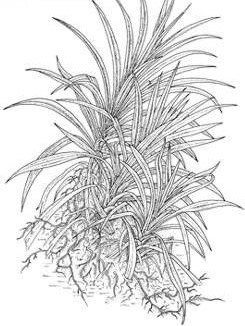
References
- The Plant List. Ver1.1. Pandanus amaryllifolius Roxb. [homepage on the Internet]. c2013 [updated 2012 Mar 23, cited 2016 Oct 18]. Available from: http://www.theplantlist.org/tpl1.1/record/kew-285639.
- Quattrocchi U. CRC world dictionary of medicinal and poisonous plants: Common names, scientific names, eponyms, synonyms, and etymology. Volume IV M-Q. Boca Raton, Florida: CRC Press, 2012; p. 397.
- Herba Malaysia. Pandan-Pandanus odorus. [homepage on the Internet] No date [updated 2011 Dec 06, cited 2016 Oct 19]. Available from: http://herba.herbal.my/pandan-pandanus-odorus.
- Wakte KV, Nadaf AB, Thengane RJ, Jawali N.Pandanus amaryllifolius Roxb. cultivated as a spice in coastal regions of India. Genet Resour Crop Ev. 2009;56(5):735-740.
- Stone BC. Studies in Malesian Pandanaceae XVII on the taxonomy of pandan wangi a pandanus cultivar with scented leaves. Econ Bot. 1978; 32(3):285-293.
- Muhamad Ghawas M. Pandan wangi (Pandanus odorus). In: Musa Y, Muhammad Gawas M, Mansor P, editors. Penanaman tumbuhan ubatan & beraroma. Serdang: MARDI, 2005; p. 63-69.
- Nor FM, Mohamed S, Idris NA, Ismail R. Antioxidative properties of Pandanus amaryllifolius leaf extracts in accelerated oxidation and deep frying studies. Food Chem. 2008;110(2):319-327.
- Ghasemzadeh A, Jaafar HZ. Profiling of phenolic compounds and their antioxidant and anticancer activities in pandan (Pandanus amaryllifolius Roxb.) extracts from different locations of Malaysia. BMC Complement Altern Med. 2013;13(1):341.
- Takayama H, Ichikawa T, Kitajima M, Aimi N, Lopez D, Nonato MG. A new alkaloid, pandanamine; finding of an anticipated biogenetic intermediate in Pandanus amaryllifolius Roxb. Tetrahedron Letters. 2001;42(16):2995-2996.
- Chaiseri S, Cheetangdee V. Free amino acid and reducing sugar composition of pandan (Pandanus amaryllifolius) leaves. Kasetsart J (Nat Sci) 40 (Suppl). 2006:67-74.
- Nonato MG, Garson MJ, Truscott RJ, Carver JA. Structural characterization of piperidine alkaloids from Pandanus amaryllifolius by inverse-detected 2D NMR techniques. Phytochem. 1993;34(4):1159-1163.
- Hidayat S, Wahyuni S, Andalusia S. Seri tumbuhan obat berpotensi hias. Jakarta: Elex Media Komputindo, 2008; p. 71-72.
- Jotisalikorn C, Tettoni LI. Thai spa book: The natural Asian way to health and beauty. C. E. Tuttle, 2003.
- Burkill IH. A dictionary of the economic products of the Malay Peninsula. Volume 2. London: Published on behalf of the governments of the Straits settlements and Federated Malay states by the Crown agents for the colonies, 1935; p. 1648-1649.
- Perry LM, Metzger J. Medicinal plants of East and Southeast Asia; Attributed properties and uses. Massachusetts: Massachusetts Institute of Technology (MIT) Press, 1980.
- Murhadi, Suharyono AS, Susilawati. Aktivitas antibakteri ekstrak daun salam (Syzygium polyanta) dan daun pandan (Pandanus amaryllifolius). Jurnal Teknol dan Industri Pangan. 2007;18(1):17-24.
- Dumaoal OSR, Alaras LB, Dahilan KG, Depadua AA, Pulmones CJG. In vitro activity of pandan (Pandanus amaryllifolius) leaves crude extract against selected bacterial isolates. JPAIR Multidisciplinary Research. 2010;4(1):102-124.
- Ooi LS, Sun SS, Ooi VE. Purification and characterization of a new antiviral protein from the leaves of Pandanus amaryllifolius (Pandanaceae). Int J Biochem Cell Biol. 2004;36(8):1440-1446.
- Sasidharan S, Sumathi V, Jegathambigai NR, Latha LY. Antihyperglycaemic effects of ethanol extracts of Carica papaya and Pandanus amaryllifolius leaf in streptozotocin-induced diabetic mice. Nat Prod Res. 2011; 25(20):1982-1987.
- Peungvicha P, Thirawarapan SS, Watanabe H. Hypoglycemic effect of water extract of the root of Pandanus odorus RIDL. Biol Pharm Bull. 1996;19(3):364-366.
- Peungvicha P, Temsiririrkkul R, Prasain JK, et al. 4-hydroxybenzoic acid: A hypoglycemic constituent of aqueous extract of Pandanus odorus root. J Ethnopharmacol. 1998;62(1):79-84.
- Peungvicha P, Thirawarapan SS, Watanabe H. Possible mechanism of hypoglycemic effect of 4-hydroxybenzoic acid, a constituent of Pandanus odorus root. Jpn J Pharmacol. 1998;78(3):395-398.
- Jimtaisong A, Krisdaphong P. Antioxidant activity of Pandanus amaryllifolius leaf and root extract and its application in topical emulsion. Trop J Pharm Res. 2013;12(3):419-423.
- Chiabchalard A, Nooron N. Antihyperglycemic effects of Pandanus amaryllifolius Roxb. leaf extract. Pharmacogn Mag. 2015;11(41):117122.
- Setyowati FM, Siemonsma JS.Pandanus amaryllifolius Roxb.. In: de Guzman, C.C. and Siemonsma, J.S. (Editors): Plant Resources of South-East Asia No 13: Spices. PROSEA Foundation.1999.Bogor. Indonesia. Database record: prota4u.org/prosea

